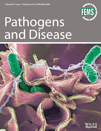Staphylococcus aureus mutants lacking cell wall-bound protein A found in isolates from bacteraemia, MRSA infection and a healthy nasal carrier
Truncated SpA, not anchored to the cell wall, can still be found during carriage or infection, underlining the fact that there is no single virulence factor in Staphylococcus aureus that is required for generating a specific type of infection.
.
Abstract
Staphylococcus aureus is a major human pathogen and a multitude of virulence factors enables it to cause infections, from superficial lesions to life-threatening systemic conditions. Staphylococcal protein A (SpA) is a surface protein contributing to S. aureus pathogenesis by interfering with immune responses and activating inflammation. Seven isolates with frameshift mutations in the spa repeat region were investigated to determine whether these mutations lead to truncation and secretion of SpA into the extracellular environment. Five isolates originated from blood cultures, one from an MRSA infection and one from a persistent nasal carrier. Full-length spa genes from the seven isolates were sequenced, and Western blot experiments were performed to localize SpA. Three isolates had identical deviating 25-bp spa repeats, but all isolates displayed different repeat successions. The DNA sequence revealed that the frameshift mutations created premature stop codons in all seven isolates, resulting in truncated SpA of different lengths, however, all lacking the XC region with the C-terminal sorting signal. SpA was detected by Western blot in six of the seven isolates, mainly extracellularly. Our findings demonstrate that S. aureus isolates with truncated SpA, not anchored to the cell wall, can still be found in bacteraemia, infection and among carriers.




